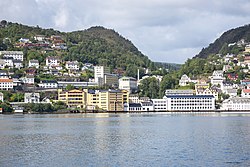
Bergen, historically Bjørgvin, is a city and municipality in Vestland county on the west coast of Norway. As of 2021, its population is roughly 285,900. Bergen is the second-largest city in Norway. The municipality covers 465 square kilometres (180 sq mi) and is on the peninsula of Bergenshalvøyen. The city centre and northern neighbourhoods are on Byfjorden, 'the city fjord', and the city is surrounded by mountains; Bergen is known as the "city of seven mountains". Many of the extra-municipal suburbs are on islands. Bergen is the administrative centre of Vestland county. The city consists of eight boroughs: Arna, Bergenhus, Fana, Fyllingsdalen, Laksevåg, Ytrebygda, Årstad, and Åsane.

Hordaland was a county in Norway, bordering Sogn og Fjordane, Buskerud, Telemark, and Rogaland counties. Hordaland was the third largest county, after Akershus and Oslo, by population. The county government was the Hordaland County Municipality, which is located in Bergen. Before 1972, the city of Bergen was its own separate county, apart from Hordaland. On 1 January 2020, the county was merged with neighbouring Sogn og Fjordane county, to form the new Vestland county.
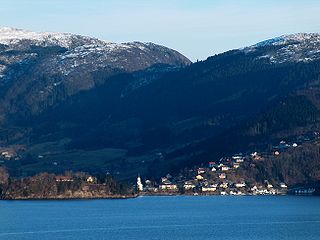
Osterøy is an island municipality in Vestland county, Norway. It is located in the traditional district of Nordhordland. The municipality encompasses most of the island of Osterøy. The administrative centre of Osterøy is the village of Lonevåg in the central part of the island. The largest settlement is the village of Valestrandfossen with 1,219 inhabitants as of 1 January 2016.
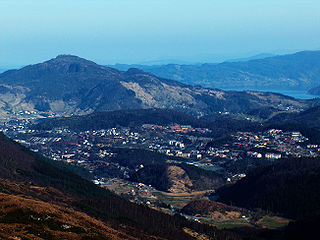
Åsane is a borough of the city of Bergen in Vestland county, Norway. The borough makes up the northern part of the city, north of the city centre.

Bruvik is a former municipality in the old Hordaland county, Norway. The municipality existed from 1870 until its dissolution in 1964. At the time of its dissolution, the municipality covered 391 square kilometres (151 sq mi) on both sides of the Veafjorden, the innermost part of the Sørfjorden, including the southeastern part of the island of Osterøy. The administrative centre of the municipality was the village of Bruvik where Bruvik Church is located.

Espeland is a village in the borough of Arna in the municipality of Bergen in Vestland county, Norway. Espeland is located north of Lake Haukeland and Mount Livarden. The village of Indre Arna lies about 4 kilometres (2.5 mi) to the north.

The Old Voss Line is a heritage railway between Garnes and Midttun near Bergen, Norway.

Haus is a former municipality in the old Hordaland county, Norway. The municipality existed from 1838 until its dissolution in 1964. The 96-square-kilometre (37 sq mi) municipality encompassed the southern half of the island of Osterøy as well as the area across the Sørfjorden from the island to the east, south, and west. The administrative centre was the village of Haus, where Haus Church is located.
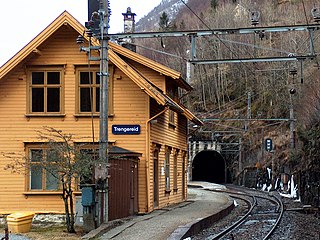
Trengereid is a local stop on the Bergen Line. It is located far east in Bergen, Norway, in the Arna borough on the shore of the fjord Sørfjord. The station is between Takvam and Bogegrend stations, at an elevation of 15.7 metres (52 ft) above sea level.
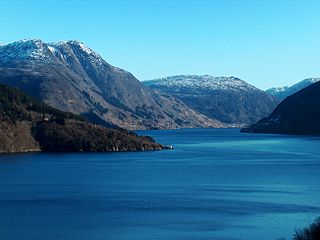
Sørfjorden is a 30-kilometre (19 mi) long fjord in Vestland county, Norway. The fjord flows around the west and south sides of the island of Osterøy, going through the municipalities of Osterøy, Bergen, and Vaksdal. The fjord begins at the village of Vaksdal where the Veafjorden flows into the Sørfjorden, it then heads west and then north before emptying into the Osterfjorden. The fjord flows past the following villages: Bruvik, Vaksdal, Hausvik, Garnes, Ytre Arna, Hylkje, Breistein, Valestrandfossen, Steinstø and Hamre.

Indre Arna is a suburban village in the borough of Arna in the municipality of Bergen in Vestland county, Norway. While Indre Arna is relatively far from most of the city centre by road, there is an 8-minute train journey through the mountain Ulriken from Indre Arna to the city centre. Arna Church is located in the village.

Ytre Arna is a settlement in the borough of Arna in the municipality of Bergen in Vestland county, Norway. Ytre Arna is principally associated with A/S Arne Fabrikker, the country's first mechanised cotton mill. Ytre Arna Church is also located in the village.

Haus or Hausvik is a village in Osterøy municipality in Vestland county, Norway. The village is located on the southwestern coast of the island of Osterøy along the Sørfjorden. The village lies across the Sørfjorden from the villages of Ytre Arna and Garnes. The village of Valestrandfossen lies about 7 kilometres (4.3 mi) north along the fjord. The 0.37-square-kilometre (91-acre) village has a population (2019) of 601 and a population density of 1,624 inhabitants per square kilometre (4,210/sq mi).

Valestrandfossen or Valestrandsfossen is a village in the municipality of Osterøy, adjacent to Norway's second-largest city and municipality Bergen, Vestland county. It lies at Sørfjorden 6 kilometres (3.7 mi) to the west and 7 kilometres (4.3 mi) south of the municipal centre of Lonevåg. Sites worth mentioning include Hamre and Hamre Church.
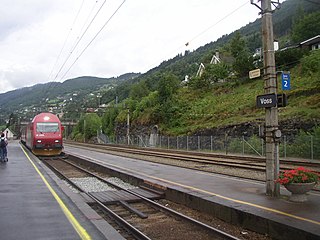
The Voss Line is a railway line from Bergen to Voss in Vestland, Norway. It opened on 11 July 1883 and was extended to Oslo as the Bergen Line on 27 November 1909. It was built as 1,067 mm narrow gauge, but converted to 1,435 mmstandard gauge with the connection with the Bergen Line. It was electrified in 1954, and shortened by the Ulriken Tunnel in 1963.

The Bergen Peninsula is a peninsula in Vestland county, Norway. The city of Bergen, Norway's second largest city, is located on the peninsula. The peninsula extends out from the mainland and it is surrounded by the following fjords: Samnangerfjorden, Bjørnafjorden, Fusafjorden, Raunefjorden, Byfjorden, Salhusfjorden, Sørfjorden. The peninsula is connected to the rest of mainland Norway by a narrow, 6.5-kilometre (4.0 mi) wide strip of land between the villages of Trengereid and Årland. The 465-square-kilometre (180 sq mi) municipality of Bergen, about 140-square-kilometre (54 sq mi) of the municipality of Bjørnafjorden, and about 50 square kilometres (19 sq mi) of the municipality of Samnanger are all located on the peninsula. The highest point is the 987-metre (3,238 ft) tall mountain Gullfjellet.

Arna is a former municipality in the old Hordaland county, Norway. The municipality existed from 1964 until 1972. It encompassed the northeastern part of the Bergen Peninsula, along the Sørfjorden, bordering the city of Bergen across the mountains to the west. The administrative centre of the municipality was the village of Indre Arna. The municipality stretched from the village of Ytre Arna to Trengereid along the coast and then inland about 8 kilometres (5.0 mi) to the Espeland area. Today, the area of the former municipality makes up the borough of Arna in the city of Bergen.
The Arna Tunnel was a proposed road tunnel which would run from Arna through the mountain Ulriken to Minde or Nygårdstangen in Bergen, Norway. It was planned to have two tubes, four lanes, and would be 8 kilometres (5.0 mi) long. It would shorten the distance of European Road 16 (E16) between Bergen and Arna by 15 kilometres (9.3 mi).
